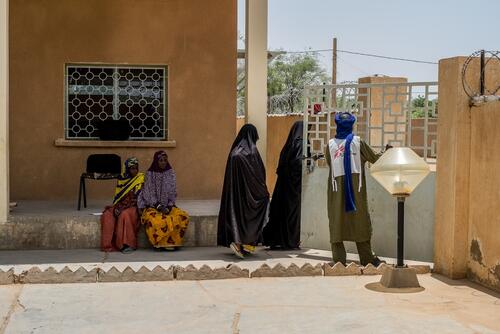Aissami Abdou, epidemiologist from Niger, has coordinated the MSF project in Ansongo, northern Mali, for the past six months. Now at the end of his mission, he sums up his experience and explains the difficulties encountered during his work in such a context.
“Ansongo is one of the four administrative divisions of the Gao region, in northern Mali. Despite the fact that it’s difficult to get reliable data, 146,000 people are estimated to be living in this area, 30,000 of them in Ansongo town. The town, which is on the left bank of the River Niger, is crossed by the road joining Niamey (in Niger) to Gao, one of the few good roads in this area.”
MSF started working in Ansongo in September 2012, nine months after the conflict broke out in the north of the country between the security forces and Tuareg and Islamist groups. At that time, the authorities in the area fled towards the south of the country, the health staff also fled due to the violence, and the health system totally collapsed.
The situation changed at the start of 2013. As a result of the military offensive launched by the French, Chadian and Malian armed forces, the rebel groups fled the main towns under their control in the north (Timbuktu, Kidal and Gao, and also Ansongo). In April, the UN mission in Mali (MINUSMA) was deployed across the area and general elections were held in July.
“So far, we cannot talk about an all-out war situation, yet we can talk about armed opposition groups launching ongoing asymmetrical attacks, such as suicide attacks. Though limited, the population still has access to healthcare, and there is ongoing fighting between the various communities in the area. This is why our presence there is so relevant.”
Currently, MSF is working at the Ansongo referral hospital, a 31-bed facility. Last February, the MSF team carried out over 4,900 outpatient consultations. 302 patients were also admitted to the hospital, of which 25 had to be referred to Gao to receive specialised treatment. The maternity ward registered 432 ANC consultations and 46 deliveries, including four C-sections.
“The epidemiological profile in Ansongo is not specific. The most common pathologies we see include malaria, respiratory infections and gastrointestinal disorders. The most acute need of the population in the area is precisely this basic medical care. Were it not for our presence, even pregnant women would lack proper care during deliveries.
On the other hand, the health system in northern Mali faces a lack of human resources, infrastructures and medicines, and the population has to pay for the medical care they receive. The ‘Bamako Initiative’ launched in Mali by the World Health Organisation (WHO), whereby the community shares the cost of the health system, needs to be taken into consideration. This was supposed to be a management model but with the crisis the system collapsed.”
By mid-March, there was a measles outbreak in Ansongo. Responding to such emergencies is among the objectives set by MSF in northern Mali. However, due to security problems, MSF was not able to lead a much-needed vaccination campaign.
“The Ministry of Health formally requested MSF’s support as we are one of the few international organisation there. We provided training and logistical support for transport and the cold chain. The campaign was carried out, but unfortunately the coverage was extremely low. Before the 2012 crisis, the north of Mali was already a forgotten place for daily vaccination activities.”
In addition to epidemic outbreaks, MSF maintains its capacity to respond to peaks of violence. Last February, MSF treated nine people with gunshot injuries at the Ansongo hospital. 30 people died as a result of the fighting between Fula and Tuareg communities, two nomadic groups that live in the vicinity of Ansongo and have historically fought over issues relating to conflicts of interests and historical grievances. MSF provided first aid to the wounded that were later referred to Gao hospital, where radiography and major surgery can be performed.
“When we received these wounded people, we decided to go up to Tin-Hama, a village 60 kilometres to the east of Ansongo to assess whether more people were in need of medical care or not. When we arrived, they explained to us that some injured people had decided to travel to Niger, about 100 kilometres away, in search of medical care, and that Fula communities had gone even further, where we could not reach them.
In Tin-Hama we found a child under two suffering from acute neuro-malaria, who was on the brink of death. Our doctor gave him first aid and then we took him to Ansongo hospital. It was difficult to convince his family, being nomadic, that they had to come with us to the hospital, and also to convince the Army at the entrance of Ansongo town that the family had to enter because they needed to go to the hospital. But we finally managed to convince everyone and the child soon recovered. There is no doubt that our trip to Tin-Hama had been worthwhile because that day we saved the life of that two-year-old boy.”
The crisis in 2012 exacerbated the differences between the different communities in the north as well as between the north and the south of the country.
“For most of the population in the area, the crisis was a very difficult time, when they felt neglected. MSF was in Ansongo throughout the crisis and that’s why the population appreciated our work.”
In 2013, MSF teams were present in the north of the country where thousands of people received preventive and curative care. MSF also provided emergency and surgical care and obstetric assistance in Kidal, Timbuktu, Mopti and Gao.



